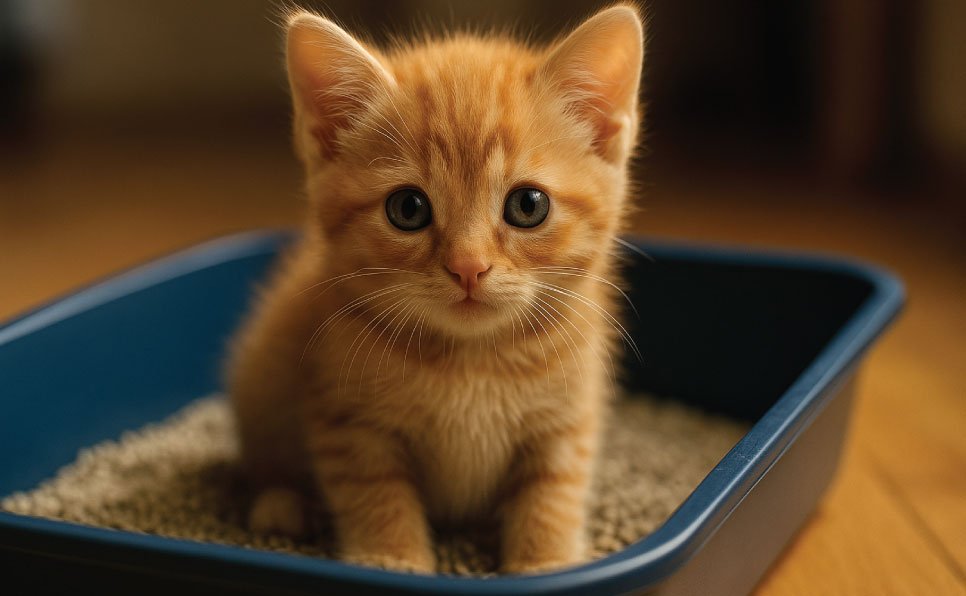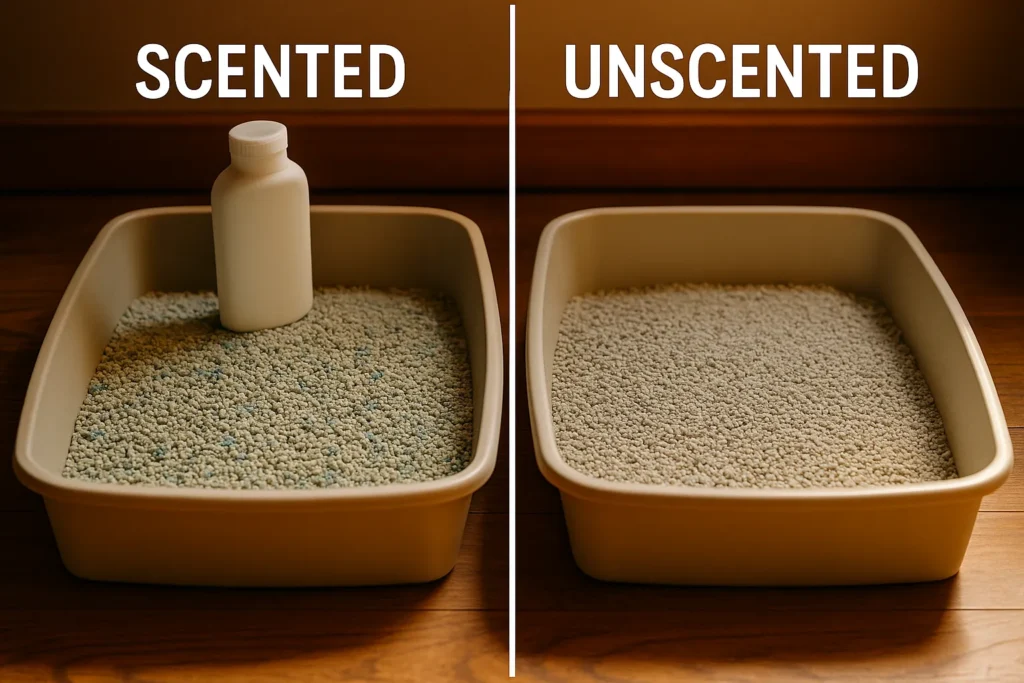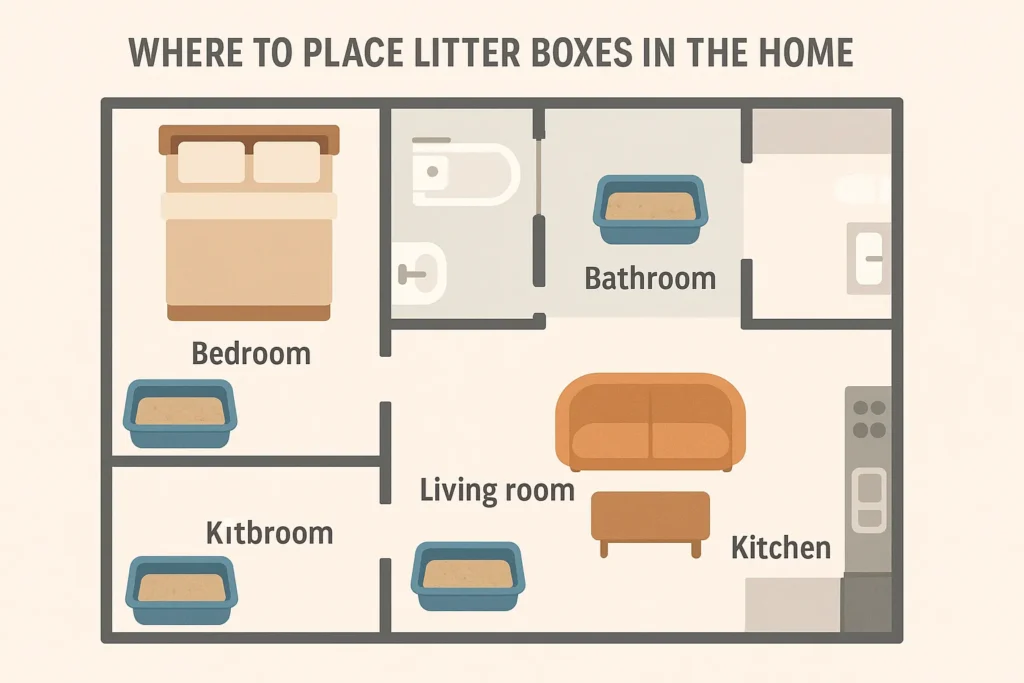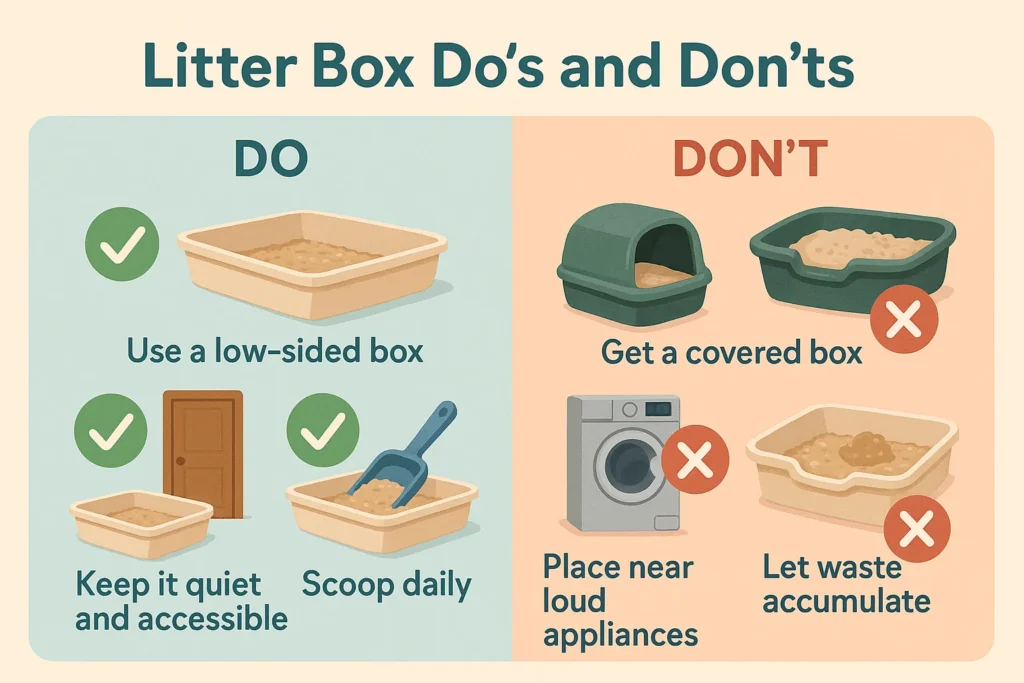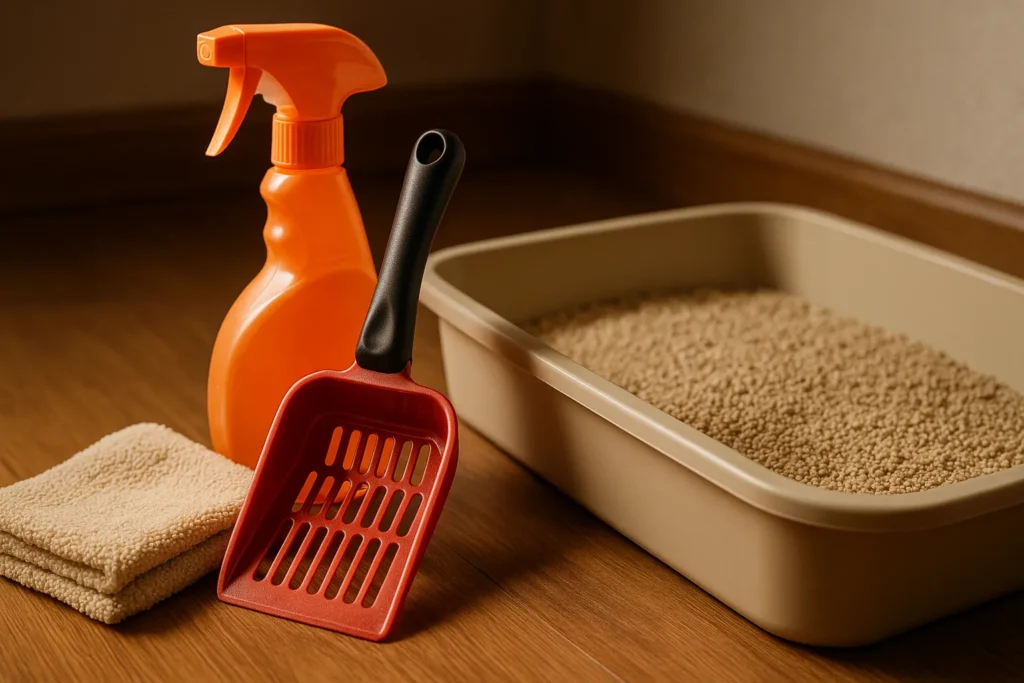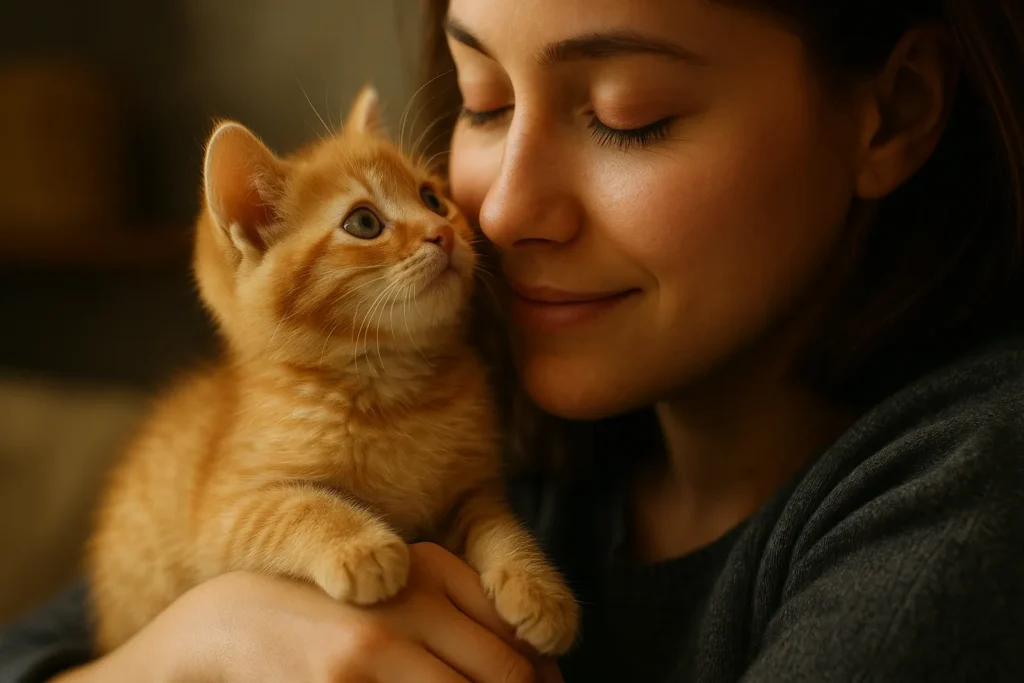Bringing a kitten home is pure magic, but so is finding poop outside the box. 😅
If you’re reading this, chances are you’re either preparing for your first kitten or currently staring at a tiny mess wondering where you went wrong. Take a deep breath. You’re not alone, and you’re definitely not failing.
Litter training is one of the first big hurdles for new cat parents, but here’s something that might surprise you: most kittens start learning litter habits by 3–4 weeks old. The trick is knowing how to guide them along the way.
Whether you’re fostering a tiny fluff ball or adopting from a shelter, this guide will walk you through everything you need to know. No overwhelm, no judgment, just practical steps to help both you and your kitten succeed.
Listen to the Podcast: Litter Box Training for Kittens
When to Start Litter Box Training
I’ll never forget bringing home my first kitten, tiny, fluffy, and absolutely clueless about where to go potty. My heart raced every time I couldn’t find him, terrified of what I might discover. But here’s what I wish someone had told me: you can actually start litter box training much earlier than most people realize.
The Perfect Age to Begin
Most kittens are ready to start litter box training around 3 to 4 weeks old. Yes, really that young! At that age, mama cat usually starts nudging them toward good habits. But if you’re raising a kitten without mom around, that gentle guidance becomes your job.
Don’t worry, it’s not as intimidating as it sounds.
Here’s what to expect:
- At 3 weeks: They’re just beginning to walk steadily
- At 4 weeks: They start exploring and can control their bladder a bit better
- By 5 weeks: Most kittens are using the box with some help
I started with a super shallow box filled with unscented, non-clumping litter. The clumping stuff can be dangerous if swallowed, and trust me, curious kittens will absolutely try a taste test.
Why Starting Early Makes All the Difference
Kittens are like little sponges, they absorb everything around them. Early exposure to the litter box helps them:
- Associate the box with the right behavior naturally
- Develop strong bathroom routines before bad habits form
- Avoid those heart-sinking moments when you find surprises in hidden corners
The earlier you start, the less likely you’ll need to break messy behaviors later. Teaching a kitten is so much easier than retraining an older cat who’s already set in their ways.
I made it a point to gently place my kitten in the box after meals and naps, those are the golden potty windows that most cat parents don’t know about.
Signs Your Kitten Is Ready
Not sure if your little one is ready to start? Watch for these telltale signs:
- Sniffing around or pawing the floor like they’re searching for the perfect spot
- Getting restless after waking up or eating
- Meowing or trying to hide, they’re often looking for privacy
- Squatting in random places (this one means act fast!)
If your kitten shows a few of these behaviors, it’s time to begin. The secret ingredient? Consistency. Make litter box visits part of their routine, and offer gentle praise every time they use it correctly.
And those inevitable accidents? They’re completely normal. Just clean up with an enzyme spray and move forward. No yelling, no shame, just patience and love.
Choosing the Right Litter Box and Litter
This part completely stumped me as a new cat parent. I assumed a litter box was just… well, a box. But kittens have very specific needs, and getting the wrong setup can turn training into an uphill battle.
Size and Type of Litter Box
For kittens, bigger definitely isn’t better. The first box I bought had sides so high that my little guy had to practically climb Mount Everest to get in. Not exactly encouraging for a tiny bladder emergency.
What works best:
- Low-sided, shallow boxes that are easy to step into
- Uncovered boxes so they can see their surroundings and don’t feel trapped
- Non-slip bottoms to prevent sliding when they step in
Honestly, even a clean baking tray or sturdy cardboard box lid works perfectly in those early weeks. Just make sure it’s easy to access and has no sharp edges.
As your kitten grows, you can graduate them to bigger boxes. Some cats eventually prefer open boxes, while others love privacy. But kittens just need to get in and out without drama.
The Safest Litter Types for Kittens
Let’s be real, kittens will try to eat litter. It’s practically a rite of passage. That’s exactly why your choice matters so much.
The safest options:
- Unscented, non-clumping litter (paper or corn-based work great)
- Natural or biodegradable options that are gentler on tiny paws
- Pellets or fine-grain textures for comfort
Avoid clumping litters until your kitten is at least 3–4 months old. If they ingest it, it can cause serious blockages. I learned this lesson after a terrifying midnight vet visit (he turned out fine, but my heart aged about ten years).
And while scented litters might smell lovely to us humans, cats typically hate them with a passion.
Avoiding Common Irritants
Steer clear of these litter box saboteurs:
- Strong perfumes or deodorants (they can overwhelm sensitive kitten noses)
- Dusty clay litters (can irritate eyes and lungs)
- Antibacterial or chemical-treated litters (not safe for kittens)
I once bought a “fresh mountain breeze” scented litter thinking it would help with odors. My kitten took one whiff and refused to even step in the box. The moment I switched to plain, unscented pine pellets, problem solved.
Keep it simple and safe. You can always upgrade to fancier options once your kitten is older and has mastered their bathroom etiquette.
Step-by-Step Training Process
Training your kitten to use the litter box might feel overwhelming, but it’s actually one of the simpler aspects of cat parenthood when you break it down. Kittens are naturally inclined to dig and bury, you just need to make sure they’re doing it in the right place (and not in your favorite houseplant).
Finding the Perfect Spot for the Litter Box
Location truly is everything. Kittens won’t want to do their business where there’s chaos, loud noises, or scary smells. I learned this the hard way when I placed the box near my washing machine. Every spin cycle sent my poor kitten scrambling for cover.
The best locations:
- A quiet, low-traffic corner away from household commotion
- Close enough to where your kitten sleeps and eats, but not too close
- Easily accessible, especially if your home has multiple levels
- Away from their food and water bowls
Avoid tucking it behind doors or furniture where it’s hard to see. You want your kitten to spot it easily and think, “Oh right, that’s my bathroom.”
If you have a larger home, consider placing multiple boxes around initially. Kittens have tiny bladders and even tinier attention spans, so convenience really helps during those urgent moments.
The Gentle Introduction
The first day home is crucial. Scoop up your little furball and gently place them in the litter box, no pressure, no forcing. Let them sniff around, maybe dig a bit with their paws, and hop out when they’re ready.
Make these visits routine:
- Right after meals (within 20-30 minutes)
- When they wake up from naps
- Anytime they start sniffing or circling (classic “I need to go” behavior)
Never force them to stay in the box. This is about creating positive associations, not stress. Think of yourself as a gentle tour guide showing them around their new facilities.
The moment they actually use the box—and I mean the very second, throw a mini celebration. High-pitched “Good job!” with some gentle petting works wonders. My first kitten literally looked proud after his inaugural successful trip. I may have gotten a little teary-eyed.
The Power of Positive Reinforcement
Here’s the golden rule that changed everything for me: never, ever punish a kitten for an accident. No yelling, no nose rubbing (that old-school method is both cruel and useless), and definitely no time-outs. Fear builds walls, not understanding.
Instead, focus on building confidence:
- Offer calm praise and gentle affection when they use the box correctly
- Keep small treats handy for immediate rewards
- Use a reassuring voice and relaxed body language
Cats are incredibly sensitive to energy. If you’re stressed and frustrated, they’ll absorb that tension and might just express their own stress by avoiding the box entirely.
Creating Consistency That Works
Kittens absolutely thrive on predictability. Set regular feeding times, and you’ll start to see natural bathroom patterns emerge. After breakfast? Box time. Post-nap? You know the drill.
Your daily success checklist:
- Keep the litter box spotlessly clean, scoop at least once daily
- Clean any accidents immediately with enzyme-based cleaner
- Gently guide them back to the box when they seem restless or squirmy
- Stick to the same routine as much as possible
Remember, this isn’t about achieving perfection overnight. It’s about establishing patterns that will serve both of you for years to come. Soon enough, your kitten will be strutting to that box like they own the place, because in their mind, they absolutely do.
Common Mistakes and How to Fix Them
Even the most devoted cat parents stumble during litter training, myself definitely included. Like the time I moved the litter box three times in one week because I couldn’t decide on the “perfect” spot. Spoiler alert: my confused kitten decided the bathroom rug was a suitable alternative.
Every mistake is a learning opportunity, so let’s tackle the most common ones together.
The Great Litter Box Migration
Kittens rely heavily on memory and scent to navigate their world. When you keep changing where their bathroom is located, you’re essentially asking them to solve a new puzzle every day.
The mistake: Constantly relocating the box to find a “better” spot.
The fix: Choose one quiet, accessible location and commit to it. If you absolutely must move it, do so gradually, just a foot or two at a time over several days.
The Perfume Problem
We humans love our fresh, clean scents. Kittens? Not so much. Some will stage a complete bathroom boycott if the litter smells too strong or artificial.
The mistake: Choosing heavily perfumed or deodorized litter.
The fix: Stick with unscented options, especially during the learning phase. Let their bathroom be a neutral, judgment-free zone. Their sensitive little noses will thank you.
The Cleaning Catastrophe
This mistake nearly derailed my entire training process. I used to grab whatever household cleaner was handy when accidents happened, until my kitten started returning to the same spots over and over. Regular cleaners don’t eliminate the scent markers that guide cats back to previous bathroom locations.
The mistake: Using bleach, regular spray cleaners, or anything with ammonia on accidents.
The fix: Invest in enzyme-based cleaners that actually break down the proteins in urine and stool. Nature’s Miracle and Rocco & Roxie are lifesavers, or you can make a DIY solution with white vinegar and baking soda.
The Dirty Box Dilemma
Picture walking into a gas station bathroom that hasn’t been cleaned in days. That’s exactly how your kitten feels about a neglected litter box.
The mistake: Skipping daily scooping or letting the box get overwhelmingly dirty.
The fix: Scoop at least once daily, more if you have multiple kittens. Do a complete litter refresh weekly. A clean box isn’t just more appealing, it actually prevents behavioral problems down the road.
Missing the Signals
Kittens often telegraph their bathroom needs through specific behaviors. Missing these cues can lead to those heart-sinking “discoveries” around your home.
The mistake: Assuming they’ll figure everything out independently.
The fix: Become a detective of kitten behavior. Watch for hovering, circling, sudden restlessness, or weird vocalizations. When you spot these signs, gently guide them to their box. Patience and attention now prevent bigger headaches later.
Dealing with Accidents Gracefully
Let’s get one thing straight: accidents will happen. Even the most well-intentioned kittens will miss their mark sometimes. The first time mine left a surprise behind the couch, I panicked, frantically Googled everything about cat behavior, then spent an hour scrubbing carpet while questioning my life choices.
Sound familiar? You’re in good company.
But here’s what I’ve learned: accidents are simply part of the learning process. How you respond can either speed up training or set you both back weeks.
Your Response Makes All the Difference
When you discover an accident, your first instinct might be frustration or disappointment. That’s completely human and totally understandable. But here’s the thing, your kitten doesn’t understand shame or guilt the way we do. They just know when the energy in the room shifts.
What to do in the moment:
- Take a deep breath and remind yourself this is normal
- Gently remove your kitten from the accident area without scolding
- Calmly place them in the litter box (even if they’re already finished)
- Offer light praise if they sniff around or dig, reinforcing the right location
You’re not correcting a “bad” kitten, you’re coaching a baby who’s still figuring out the rules of their new world.
The Science of Proper Cleanup
Cleaning accidents properly isn’t just about aesthetics, it’s about preventing repeat performances. If a spot still smells like bathroom to your kitten, they might think, “Perfect! I found my outdoor toilet!”
Your cleaning game plan:
- Use enzyme-based cleaners specifically designed for pet messes (they literally eat the odor-causing bacteria)
- Avoid anything with ammonia, which can actually mimic the scent of urine
- Blot, don’t rub, you want to lift the mess, not grind it deeper into surfaces
- Let the area dry completely before allowing your kitten back
For extra protection:
- Temporarily place a litter box near the accident site, then gradually move it back to the original location
- Block access to the cleaned area with furniture or pet gates while scents fade completely
One well-placed rug accident taught me that proper cleaning isn’t optional, it’s essential for long-term success.
When Accidents Signal Something More Serious
Sometimes repeated accidents aren’t about training at all, they’re your kitten’s way of telling you something’s wrong. If you notice any of these red flags, it’s time to call your veterinarian:
- Sudden regression after weeks of successful box use
- Straining to urinate or defecate
- Crying or meowing in pain during elimination
- Blood in urine or stool
- Excessive accidents despite consistent training
These symptoms could indicate urinary tract infections, parasites, or other medical issues that no amount of patient training can resolve. Trust your instincts, it’s always better to rule out health problems than to assume it’s just a behavioral phase.
Remember, you know your kitten best. If something feels off, don’t hesitate to seek professional guidance.
Tips for Faster Success
When I was in the thick of kitten chaos, I desperately wanted shortcuts, anything to make litter box training happen faster without losing my sanity (or my security deposit). The wonderful news? There are absolutely ways to help your kitten learn more quickly while keeping stress levels low for both of you.
The Magic of Meal Timing
Want to become a kitten bathroom psychic? Pay attention to their feeding schedule. Most kittens need to eliminate within 20-30 minutes after eating, it’s like clockwork once you start noticing the pattern.
Set yourself up for success:
- Establish regular feeding times (3-4 small meals work best for young kittens)
- Guide them to the litter box after each meal
- Stay nearby during those critical post-meal minutes
- Celebrate every successful bathroom trip
This predictability gives you multiple daily opportunities to reinforce good habits, turning routine meals into training victories.
The Multiple Box Strategy
One litter box might not be enough, especially during the learning phase. The general rule that changed my life: one litter box per cat, plus one extra.
Strategic box placement:
- Quiet corners on each floor of your home
- Near where accidents have previously happened (temporarily)
- Away from food and water areas
- Easily accessible from your kitten’s favorite hangout spots
More boxes equal more opportunities for success and fewer emergency situations where your kitten can’t make it to the “official” bathroom in time.
The Attraction Factor
This tip feels almost like cheating, some litters are actually formulated to be irresistible to kittens. They contain safe, natural scents that encourage proper box usage.
Look for:
- “Kitten attract” formulas (Dr. Elsey’s makes an excellent one)
- Natural options with added beneficial herbs
- Litter box attractant powders you can sprinkle on regular litter
I was skeptical until I tried this with a particularly stubborn foster kitten. Within 48 hours, he went from bathroom rogue to litter box champion. Sometimes a little help from science makes all the difference.
Celebrate the Small Wins
Every single time your kitten uses the box correctly, make it a moment worth remembering. Treats, gentle praise, soft petting, these positive associations build confidence and motivation.
The flip side: Don’t dwell on accidents. Don’t get frustrated. Just clean up, reset, and try again with fresh optimism.
Kittens genuinely want to make you happy. They just need consistent guidance, infinite patience, and a cheerleader who believes in their potential.
Quick Wins That Make a Big Difference
- Maintain pristine box conditions, scoop daily, refresh weekly
- Keep boxes easily accessible at all times
- Avoid sudden changes in litter type or box location
- Be patient with the process, every kitten learns at their own pace
- Trust the timeline, most kittens are reliably trained within 2-4 weeks
Litter Box Training for Kittens. Frequently Asked Questions (FAQs)
Yes, but be cautious. Some kittens may chew or scratch at the liner, which could be a choking hazard or lead to ingestion. If you use one, opt for non-slip, unscented liners and monitor your kitten’s behavior closely.
Even with daily scooping, it’s best to fully replace the litter every 1–2 weeks to keep bacteria and odor in check. For multiple kittens or sensitive noses, consider changing it weekly.
Not recommended. Kittens can be curious and small enough to get injured. It’s better to wait until they’re at least 5–6 months old before introducing an automatic litter box.
Use a waterproof litter mat or silicone tray under the box. It catches scattered litter and any “overflow” without damaging your floors. Avoid plush rugs, which can trap odor and bacteria.
Yes, but do it gradually over several days. Move it a few feet at a time toward the new spot to avoid confusing your kitten. Sudden moves may cause accidents.
Avoid placing the litter box near cleaning chemicals, essential oil diffusers, or space heaters. These can irritate your kitten’s lungs or skin. Also, avoid food bowls nearby to prevent contamination.
Conclusion
Litter box training might feel like a mountain to climb when you’re holding a tiny, confused kitten, but I promise you, it’s absolutely achievable with the right approach. You’re not just teaching bathroom etiquette; you’re building the foundation for a lifetime of trust, routine, and peaceful coexistence.
The journey requires patience, yes. Consistency, absolutely. But mostly it requires you to show up with love and understanding, even on the days when you find surprises in unexpected places.
Start early when possible, stay consistent with your approach, and please don’t stress about the inevitable accidents. Celebrate every victory, no matter how small, that first successful trip to the box is worth a little happy dance. Remember that every kitten learns at their own pace, and comparing your little one to others will only add unnecessary pressure.
Most importantly, trust yourself. You chose to bring this kitten into your life because you have love to give. That same love and dedication that drew you to cat parenthood is exactly what will carry you both through this learning phase and into years of companionship.
The sleepless nights, the surprise cleanups, the moments of doubt, they’re all temporary. But the bond you’re building and the habits you’re establishing? Those are the gifts that keep giving, creating a foundation for a happy, healthy life together.
You’ve got this, and so does your kitten. Every successful litter box trip is proof that you’re both learning and growing together. 💛

